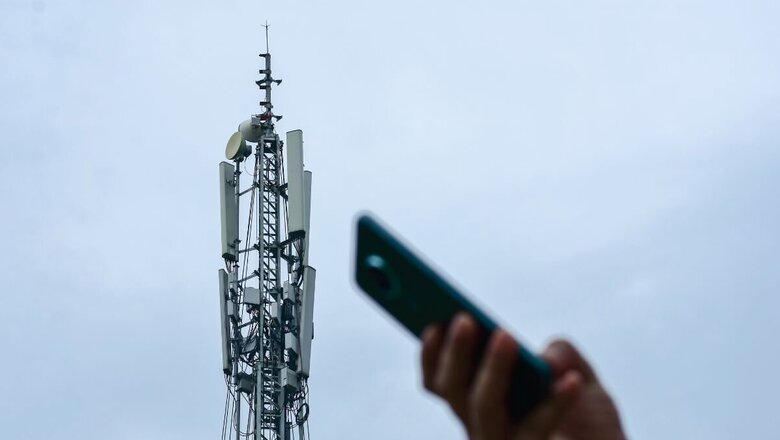
views
As Japan unveils a groundbreaking prototype showcasing the immense potential of 6G technology, the global race for next-generation wireless networks intensifies. This development poses a crucial challenge for India, prompting a reevaluation of its 6G strategy to address both international competition and domestic requirements.
The unveiling of a wireless device capable of reaching unprecedented data transfer speeds of 100 Gbps—apparently 500 times faster than 5G at its peak—underscores the urgency for India to recalibrate its approach in harnessing the transformative power of 6G.
The prototype, a result of collaborative efforts by Japan’s telecommunications giant NTT, mobile operator DOCOMO, and electronics corporations NEC and Fujitsu, demonstrates the utilisation of high-frequency bands in the 100 GHz and 300 GHz range. This breakthrough technology opens doors to a multitude of possibilities, enabling data transfer rates that could facilitate the streaming of multiple high-definition movies simultaneously.
In the global landscape, countries such as South Korea, China, as well as North American and several European nations are forging ahead with ambitious 6G initiatives, setting the stage for a new era of connectivity and innovation. But where does India stand?
Lt Gen Dr SP Kochhar, Director General of the Cellular Operators Association of India (COAI), told News18: “Countries ahead of the curve may showcase good results initially, and if their results conform to international standards, the benefits will accrue to all the countries globally, a positive for all. But in case these results do not conform to the global standards, it would get reduced to a demonstration only, which cannot be commercialised.”
However, while “taking the lead” might involve achieving the first prototype, it can also be interpreted as commercialisation and real-world applications. So, in this case, the obvious question will be, while Japan has taken a step ahead, there are other countries who are competing in the same race, considering the current stage of development, what’s a realistic timeline for India’s 6G progress?
Dr Kochhar emphasised the importance of creating a roadmap in tandem with international standards to achieve leadership in 6G, something which the government released last year, calling it Bharat 6G Vision. The vision document identifies key research pathways that are being pursued globally and that are particularly relevant for ideating new possibilities in the Indian context.
“Simultaneously, there needs to be research on the equipment/device ecosystem, which is something that is required to be done by or in conjunction with the OEMs, as it cannot be done by the government alone. In this regard also, India has taken steps to see that the requisite manufacturing and R&D can be developed to facilitate the needs and this is work in progress presently. For example, OEMs like Nokia and Ericsson are establishing 6G labs in India, setting the stage for ground-breaking research and development,” noted Dr Kochhar.
The challenge lies not only in technological advancement but also in identifying suitable applications that can be commercially viable—a lesson learnt from the rollout of 5G. So the DG of COAI believes that the work has to begin with identifying suitable applications that can be serviced by 6G, which is a global effort and discussions on this are ongoing in various countries across several industries.
However, the roadmap outlined by the 6G Vision document envisions a future where hyper-connectivity and enhanced experiences drive societal transformation. Key research pathways include exploring new spectrum bands, leveraging AI and machine learning, integrating space-based assets, and developing innovative user interfaces. The vision extends beyond technological prowess to address socio-economic disparities, aiming to bridge the digital divide and empower rural communities.
It also says that India has a vision to design and build its own 6G devices based on 6G standards, network and performance expectations, and the use cases that the devices are expected to support. “We propose an inside-out approach involving developing the required silicon level IPs, interfaces, and chips and enabling the leading applications to use the existing semiconductor and devices ecosystem. We may also own and steer a couple of strategic and mission-critical components, chips, devices and applications to showcase end-to-end capabilities as part of the 6G test bed program,” it noted.
Furthermore, the document highlighted that the current R&D funding mostly goes towards processor design, neglecting crucial 5G and 6G modem chipsets. To address this, the document talks about significant funding over 10 years, focusing on these modem chipsets and the entire system (software, security, and applications). This funding should also support research on new technologies like VR and advanced sensors that will be essential for 6G devices.
While talking about the 6G rollout, Dr Kochhar said: “We don’t think there will be any major change in the projected time, that is 2030, for a commercial rollout. Experimental setups would come up here and there periodically which would guide India, but at a commercial scale, standardised 6G products ready for rollout with some applications in mind, may not happen before 2030.”a




















Comments
0 comment